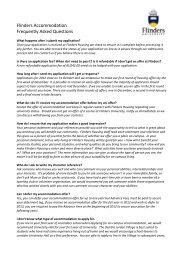Flinders Biomedical Engineering Equipment Orientation
Flinders Biomedical Engineering Equipment Orientation
Flinders Biomedical Engineering Equipment Orientation
You also want an ePaper? Increase the reach of your titles
YUMPU automatically turns print PDFs into web optimized ePapers that Google loves.
Capnographs – Basics<br />
Abbreviation / other<br />
names<br />
What does<br />
"Capnograph" mean?<br />
<strong>Flinders</strong> <strong>Biomedical</strong> <strong>Engineering</strong><br />
A joint department of <strong>Flinders</strong> Medical Centre<br />
and <strong>Flinders</strong> University of South Australia, Faculty of Health Sciences<br />
End Tidal CO2 (ETCO2), Expired CO2 Monitor<br />
Capno = Carbon dioxide<br />
Graph = Graphic display read out or recording.<br />
What does it do? A Capnograph measures the amount of CO2 in the expired air from the lungs of a patient.<br />
Physiology Cells of our body require oxygen, which is given to them via the blood. O2 is given to cells, and<br />
when used the waste gas, CO2, produced within the cells is exhausted into the blood. The Blood<br />
then transports it to the capillaries in the lungs and the CO2 is then transferred into the air in the<br />
lung. As the lungs exhale the CO2 is exhausted to atmosphere.<br />
How it works There are two types of Capnographs, Main stream or Side stream. Main stream. Capnographs<br />
have a CO2 sensor that attaches to a disposable airway adaptor inserted between the<br />
endotracheal tube in the patient and the ventilator circuit (after the wye piece). The sensor is<br />
made up of a light source that sends infra red light through the adaptor, the sample of gas and a<br />
filter chopper wheel to the photo detector. Infra red is absorbed by CO2 in the exhaled gas. The<br />
more CO2 gas the more the infra red is absorbed and less reaches the photo detector.<br />
This signal is sent to the Capnograph and processed to give a graphic reading on the screen. The<br />
Side stream Capnograph takes a sample of gas from the airway (from the same place as the<br />
Main stream sensor) through a small tube into the Capnograph and all of the measurement and<br />
signal processing takes place inside the Side stream Capnograph. (same method as Main stream<br />
Capnograph)<br />
Units of measurement %, mmHg partial pressure.<br />
Picture of equipment<br />
Novametrics Tidal Wave<br />
<strong>Orientation</strong> pages created and compiled by FBE: mailto:fbe.support@health.sa.gov.au<br />
Back

















